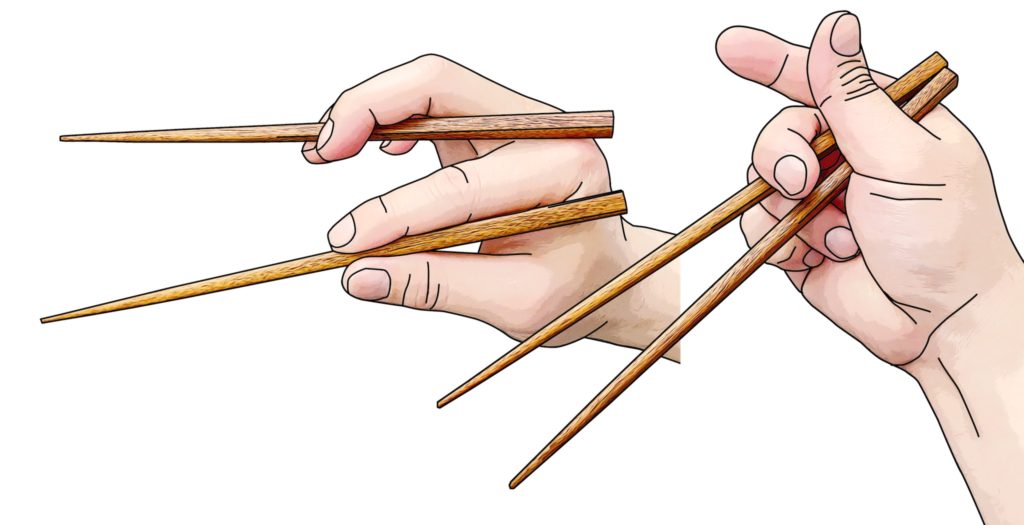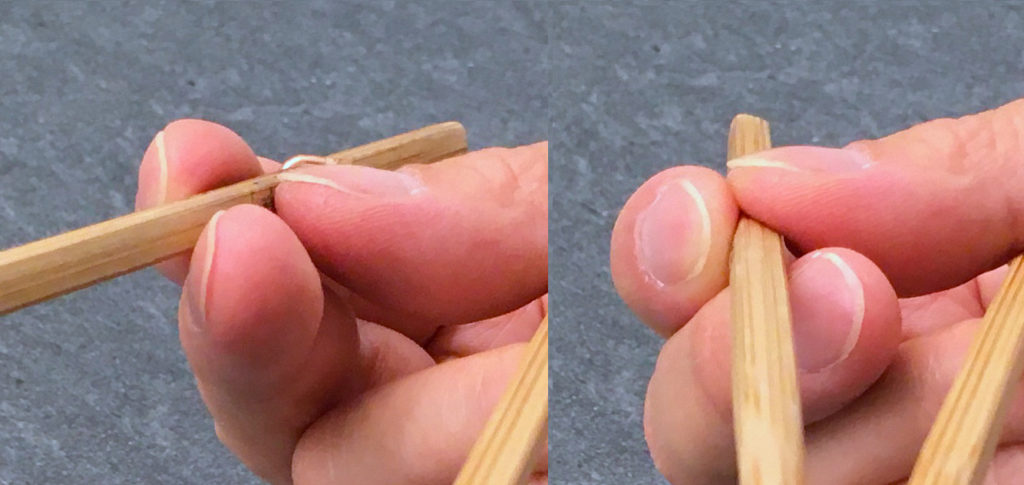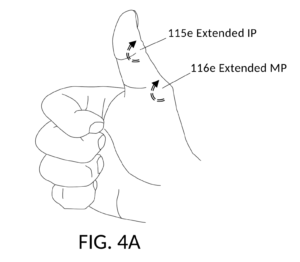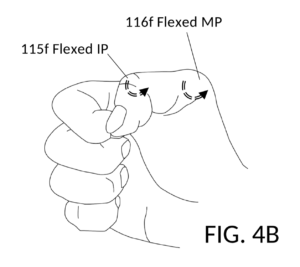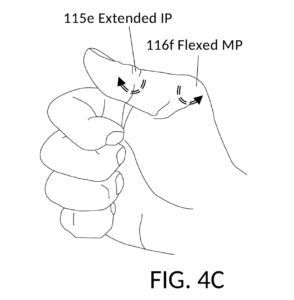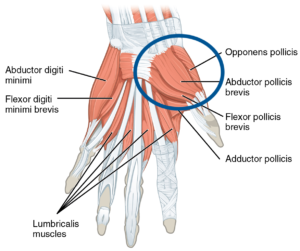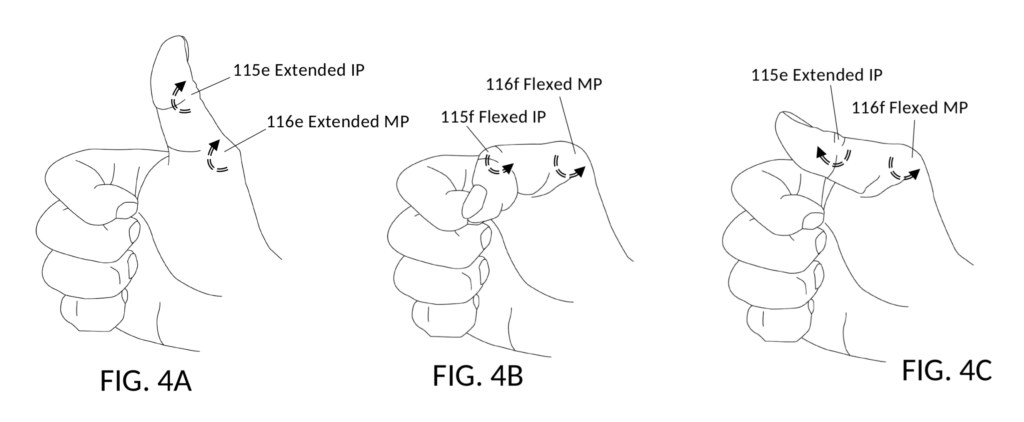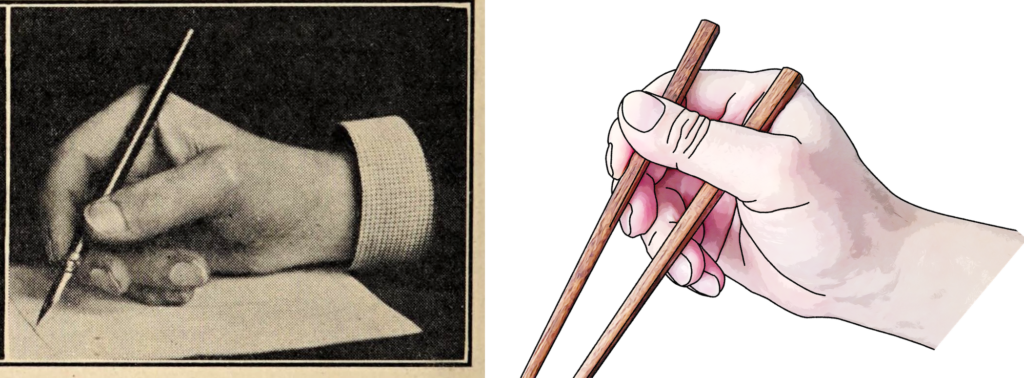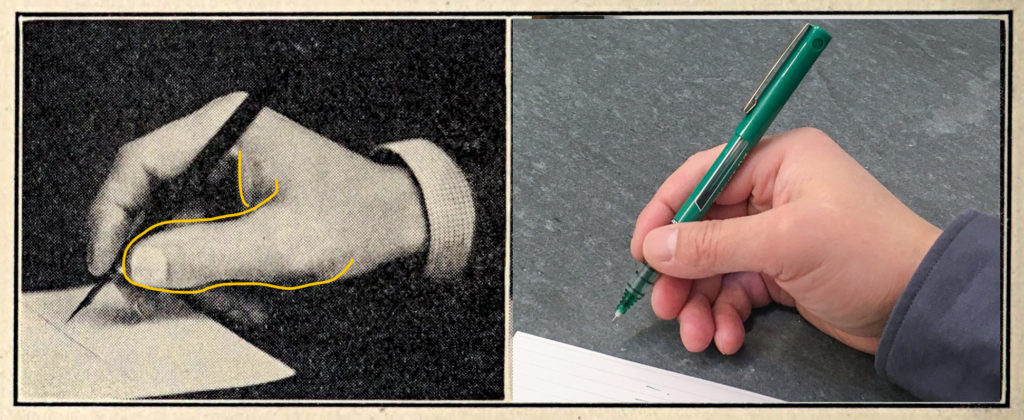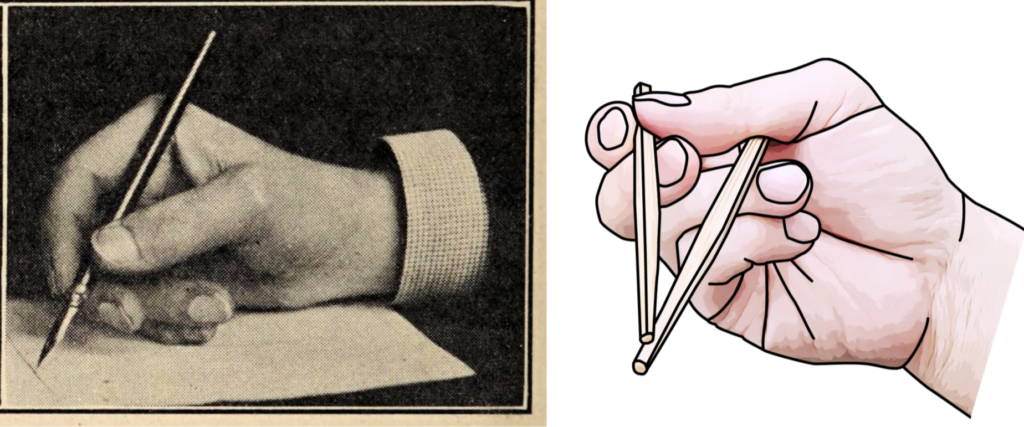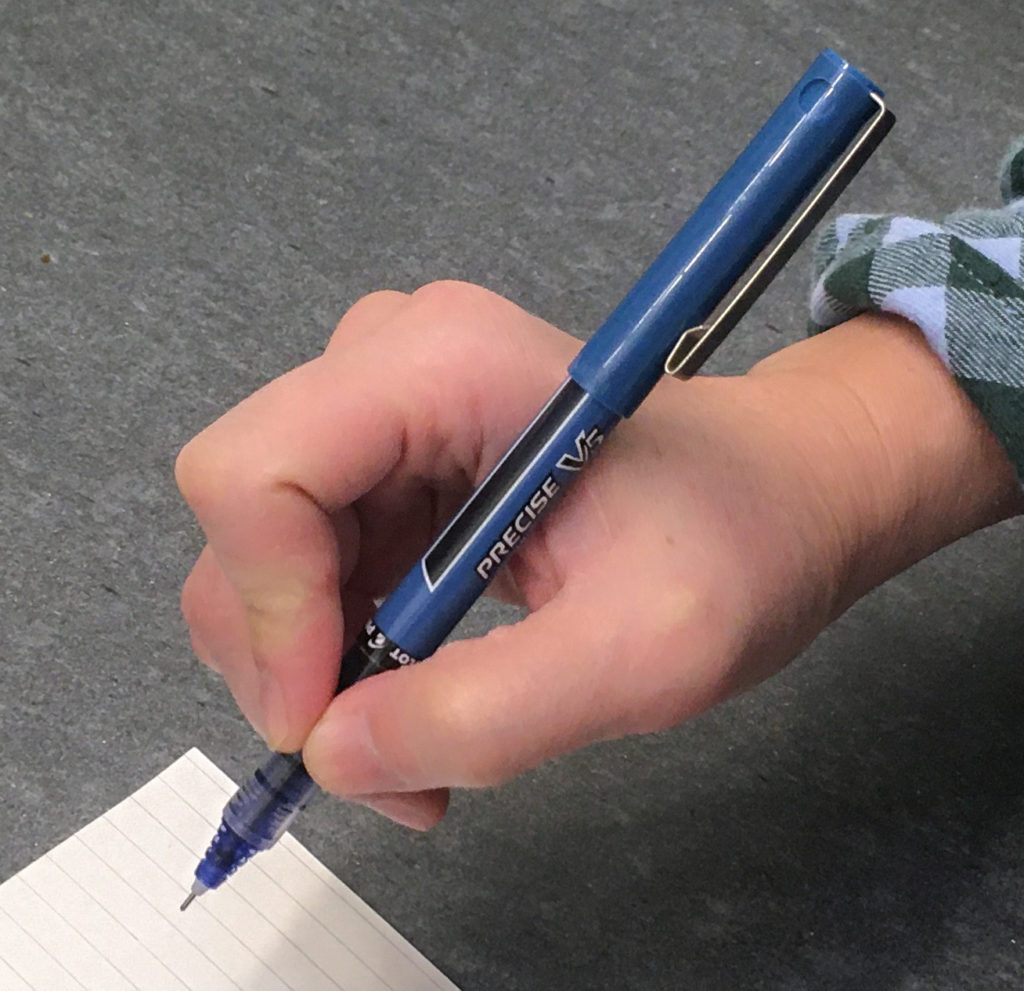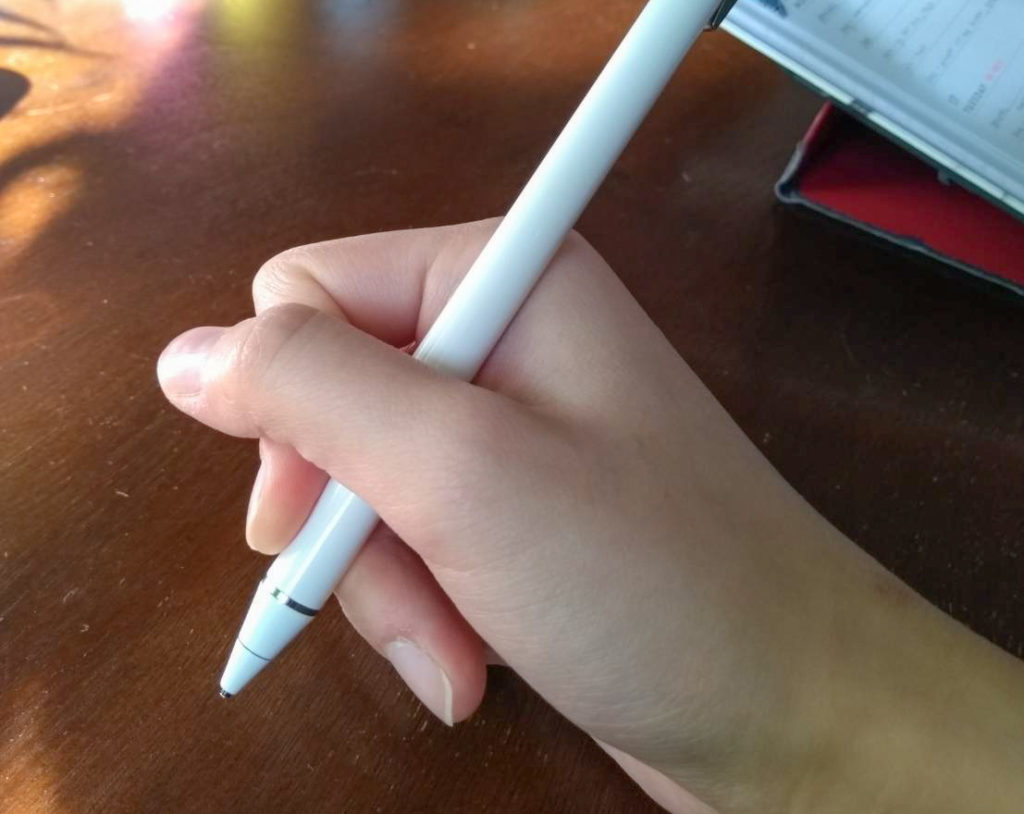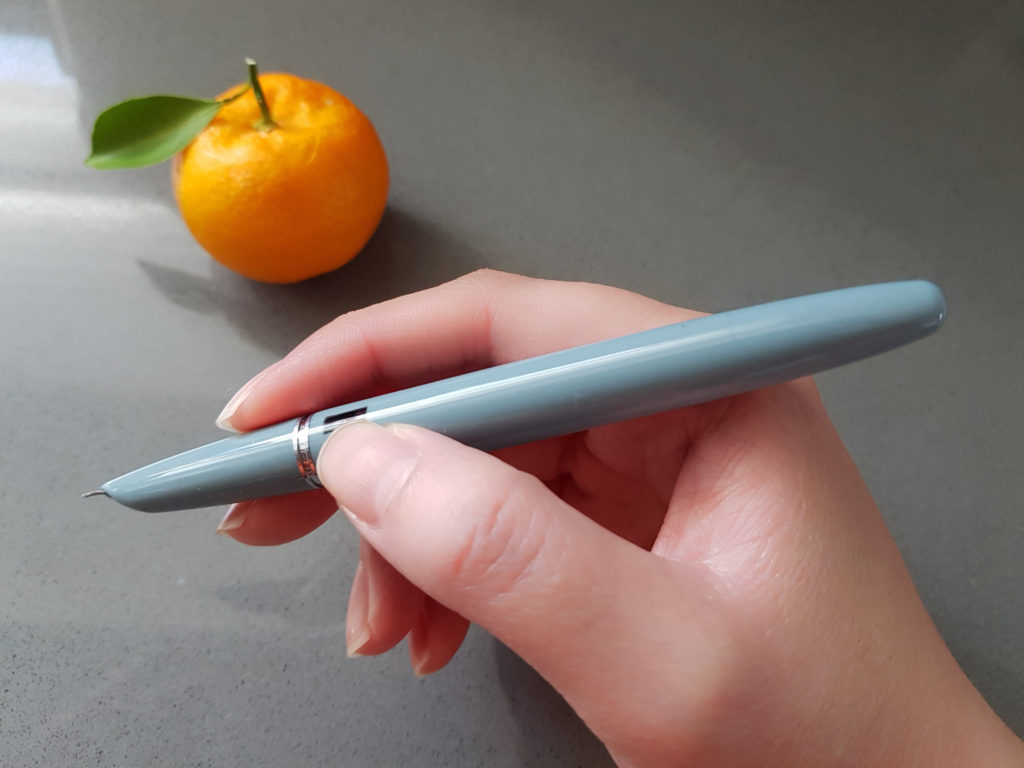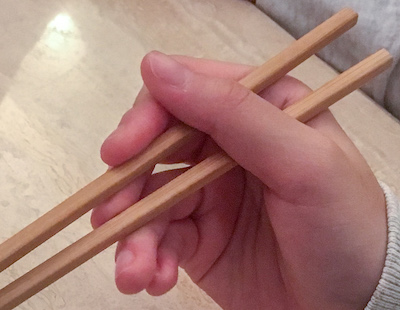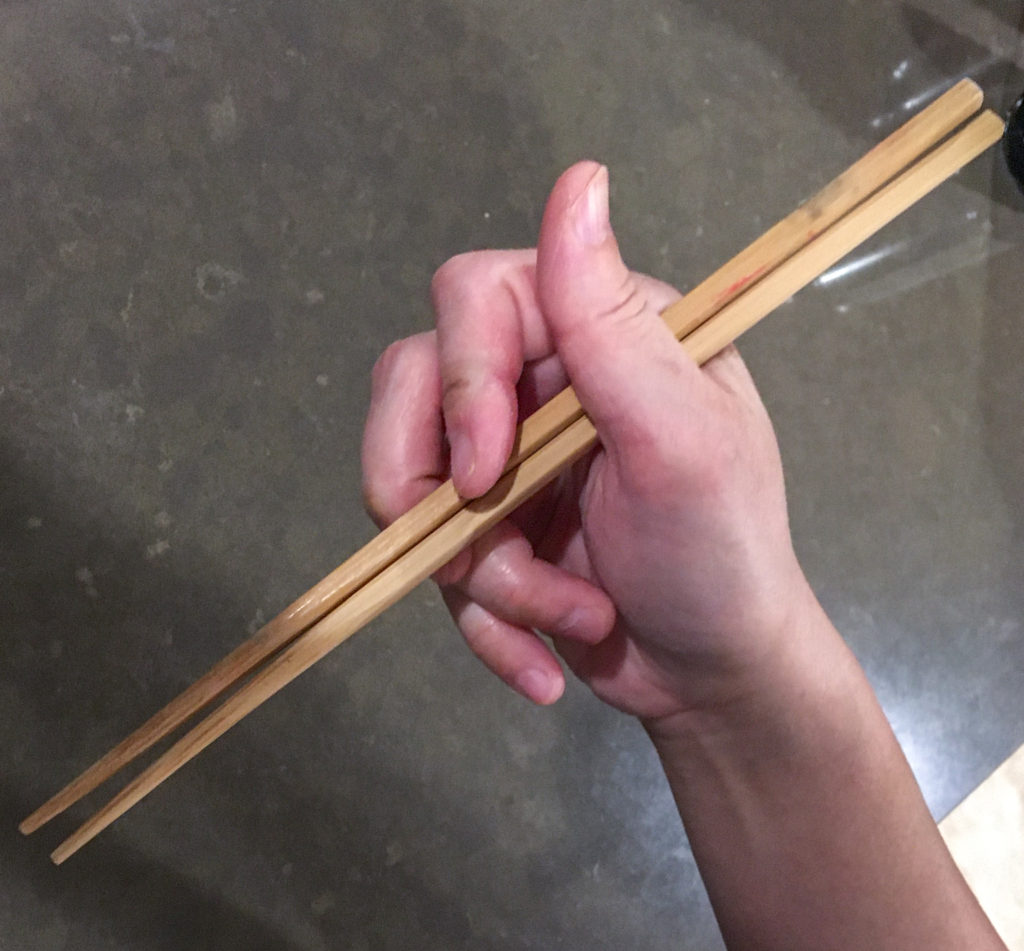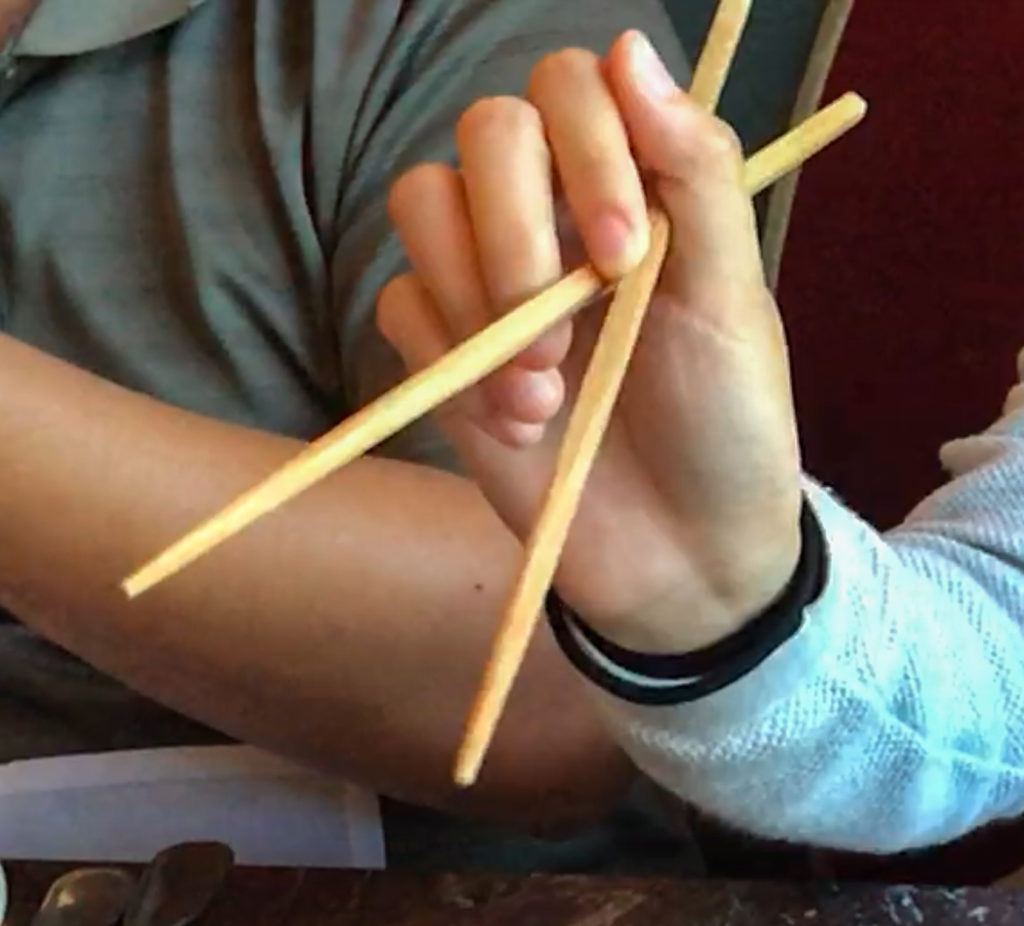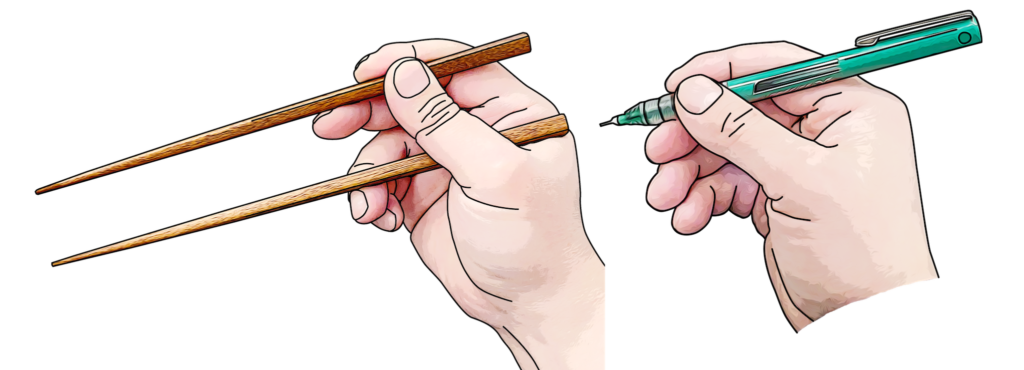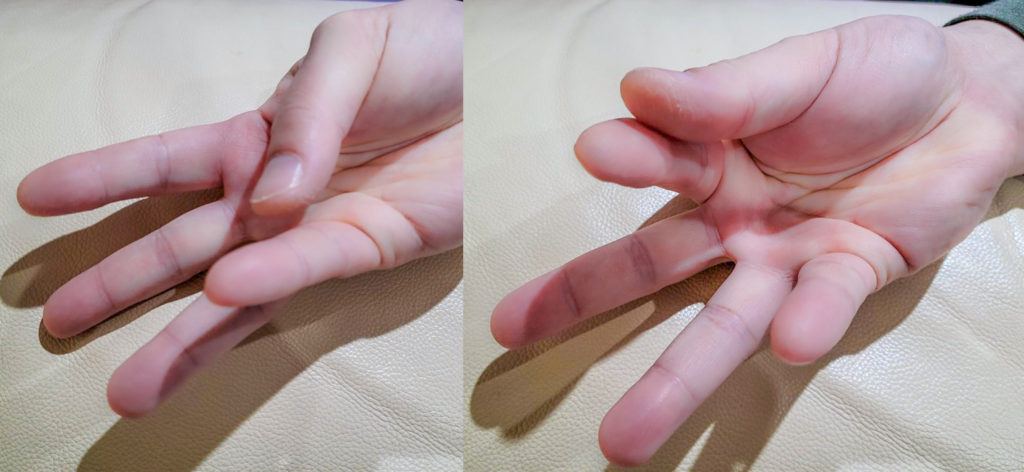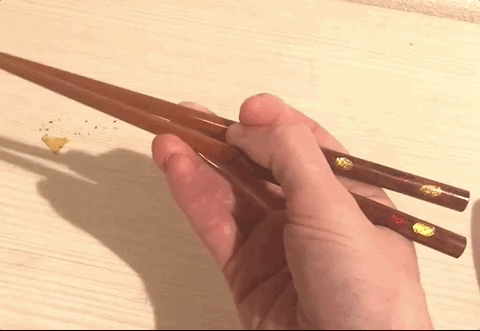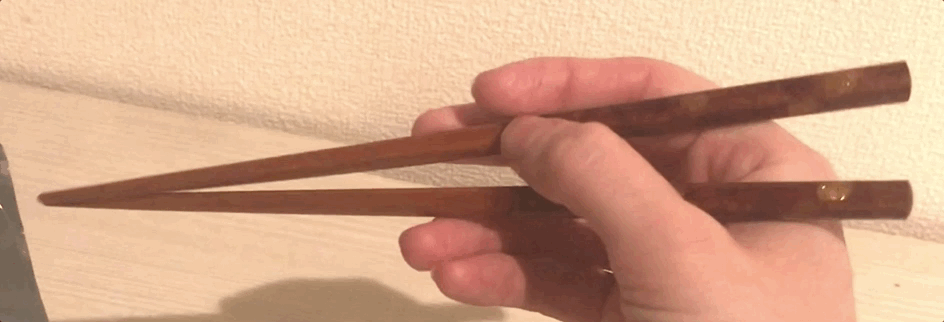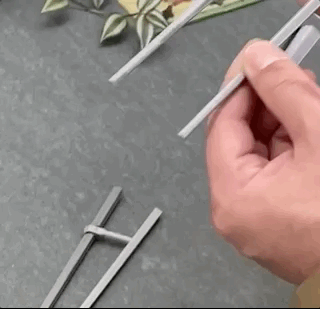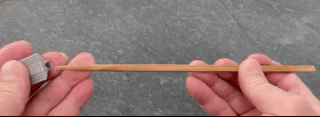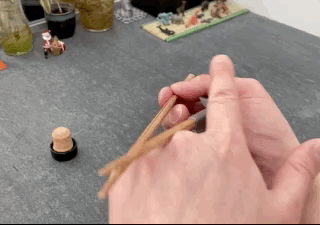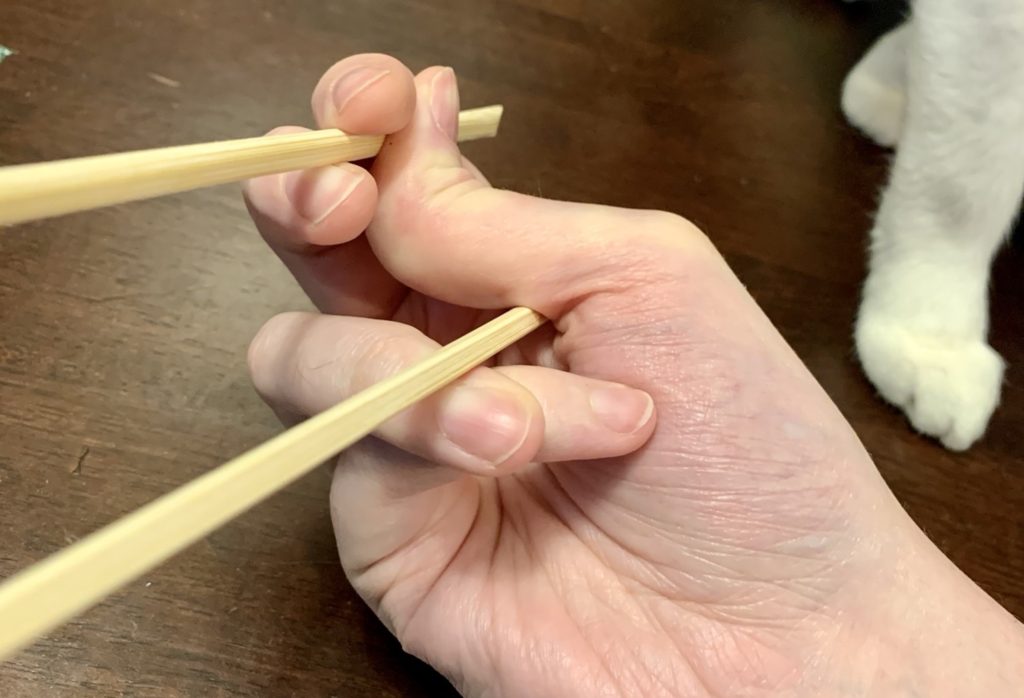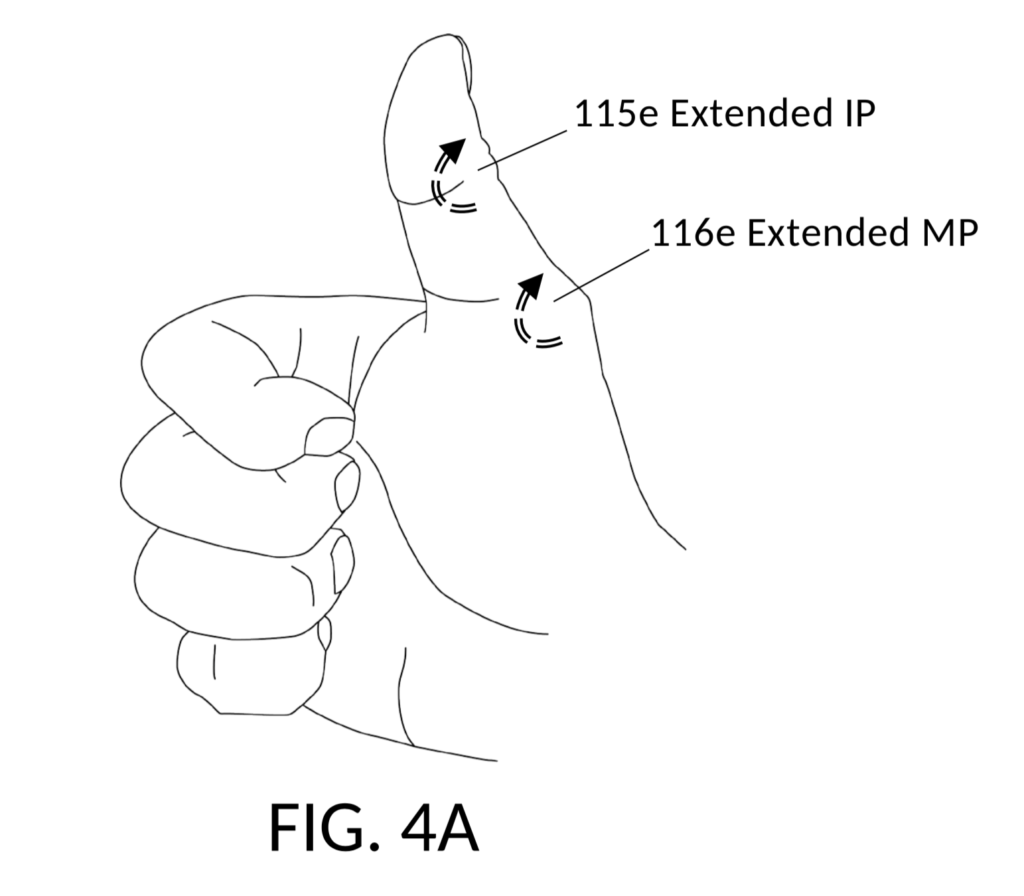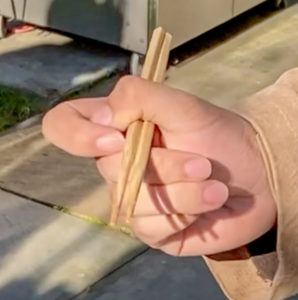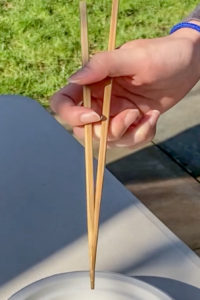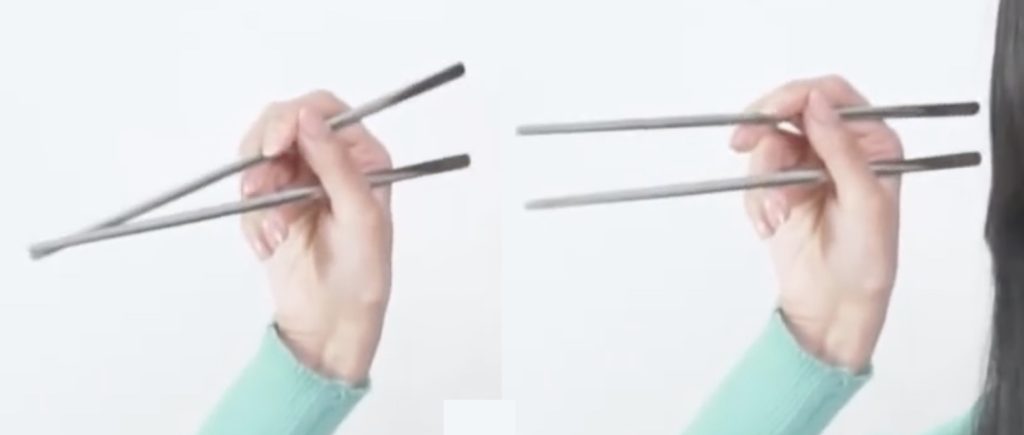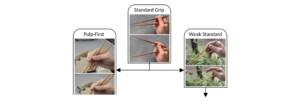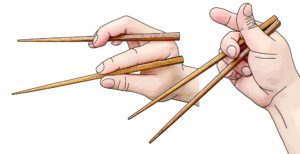Last Updated on July 8, 2021 by Staff
To use marcosticks (read: chopsticks) with the Standard Grip, a flattened, unnatural thumb pose we call Caswellian thumb is needed. Unfortunately, we believe that a substantial human population cannot comfortably move their thumb into this pose, or at least not for a substantial amount of time.
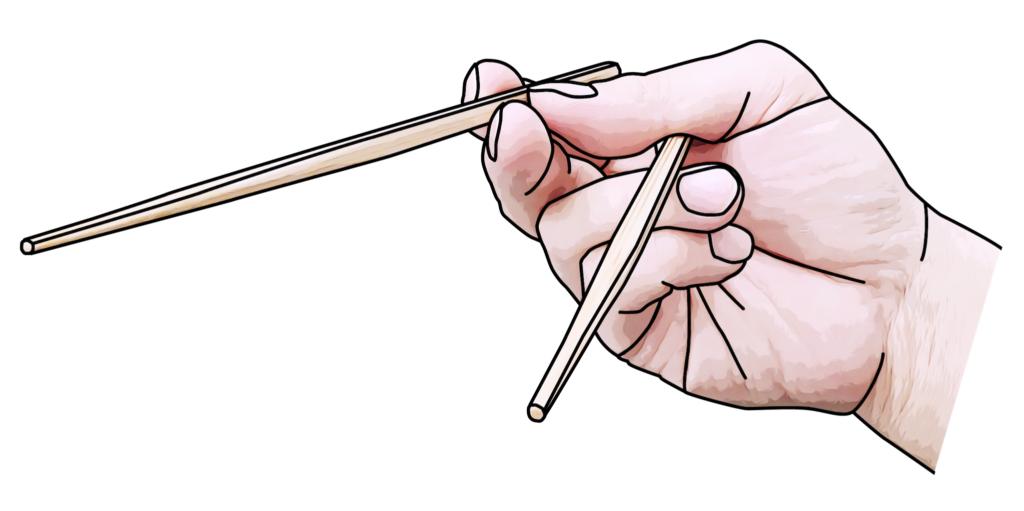
This unnatural thumb pose is a major contributor to chopstick cramp, an underreported issue in chopsticking.
This has real-world implications. In most chopstick-using cultures, not being able to use the standard grip often reflects negatively on someone’s home environment. We have already explained, in Using vs Not Using the Thumb, how preschoolers are often coerced into adopting a non-standard grip early on, due to their inability to wield long and heavy chopsticks properly.
But we now think that Standard Grip may not be for everyone. We have heard from hundreds of people in our 4-hours of fame on Reddit. We now understand that Caswellian thumb is beyond anatomical abilities of many. Perhaps alternative grips such as Count-to-4 or The Equal Opportunity are better choices, for these users.
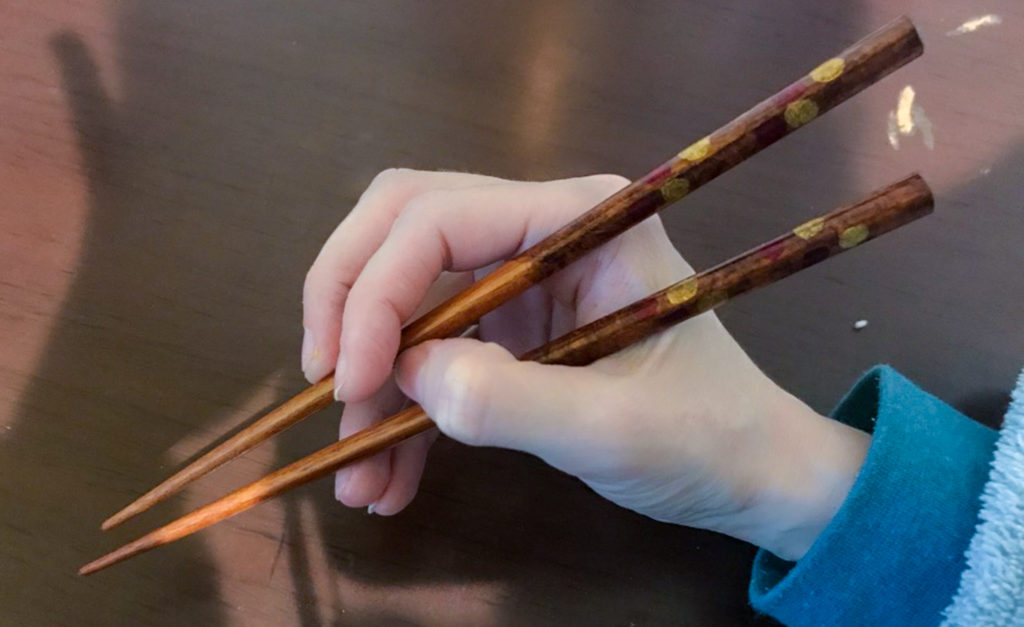
In a retrospective, The Art and Science of Chopsticking, we dove deeper into the issue of creating a menu of alternative grips. These could serve as options for folks who find such grips easier to wield than Standard Grip.
Table of Contents
What is known about hand grips
Humans and great apes are basically the only animals with opposable thumbs1. The opposable thumb enables a wide variety of grips that are unique to us. In the research field, these grips are known as either 2-finger or 3-finger “pinches”.
The chopstick tripod hold is a 3-finger pinch. In this field, such tripod hold is classified as a dynamic grip, as opposed to a static grip, because muscles move fingers throughout the use of chopsticks.
But there are many types of 3-finger, dynamic pinch. They command different finger dynamics. Coverage in literature on further classification of this topic is sporadic.
Some research work came close to describing the chopstick tripod hold. For instance, in Biomechanics of the Hand (Duncan et al), pinches are classified into 7 types. The oppositional pinch (aka subterminal pinch) almost describes the tripod hold. The word “subterminal” is used in contrast to “terminal”. Terminal opposition means the use of a terminal end (tip) of the thumb and another finger. Subterminal means that the “pad” of the thumb, rather than the tip of the thumb is used in a grip. Note how the subterminal pinch on the right employs a flattened thumb, similar to that in the tripod hold.

However, subterminal is not a good label for describing the thumb pose in the tripod hold. Recall that the tripod hold is a dynamic pinch. Look at the two tripod hold pictures again. At the open posture on the left, the terminal tip of the thumb is actively rolling the top stick. At the closed posture on the right, the subterminal pad of the thumb is rolling the top stick. The tripod hold is both terminal and subterminal, in this sense.
What research literature really imply by “terminal” vs. “subterminal”, is whether the first segment of fingers are straight, or bent. In medical French, one would say that terminal opposition is where distal interphalangeal joints are flexed, and subterminal opposition is where they are extended. In wielding chopsticks, the first thumb segment is always extended (flat and straight), but the index finger and the middle finger are flexed (bent).
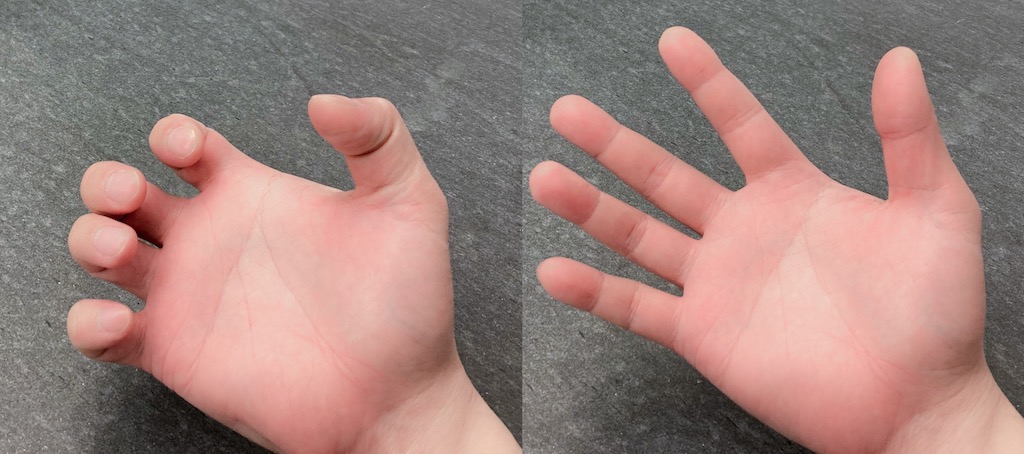
So, terminal vs. subterminal is not the right way to describe the chopstick tripod hold. But even this crude subterminal distinction in research literature is found few and far between. Most literature don’t care about subterminal anything, because as you will see further down this article, most human activities do not seem to rely on subterminal pinch, with uncomfortably flattened tip finger segments.

As the opening of this article mentioned, the flattened, unnatural thumb pose is not a universal human trait. Perhaps the population of people who cannot wield this thumb pose is as large as those who can do the hitchhiker’s thumb. Perhaps in chopstick-using cultures, parents has been unreasonably asking children to “use the right way” to hold chopsticks, when many of them are physically unable to comply. Repeated attempts in forcing this thumb pose case may lead to chopstick cramps.

If you want to go down the rabbit hole of grip research, we recommend these:
- Biomechanics of the Hand (Duncan, et al)
- Adult prehension: Patterns and nomenclature for pinches (Casanova, et al)
- GRASP Taxonomy of Human Grasp Types (Feix, et al)
- and this strange but wonderful and beautiful Russian blog, with a seemingly auto-translated English title: Painful techniques on the joints of the fingers, by whoever wrote it.
- Pencil grip: A descriptive model and four empirical studies. Selin 2003.
Familiar hand gestures
The best way to define the Caswellian thumb is to contrast it to other thumb poses in familiar hand gestures. To do so, however, we’ll have to use medical French again. So here we go.
The thumb, unlike the other fingers of the hand, has only two segments (phalanx), instead of three. The two segments are connected by the interphalangeal (IP) joint. The base segment is connected to the palm by the metacarpophalangeal (MP) joint. These two joints play a significant role in many learner’s struggle with the Standard Grip.
Figure 4A above illustrates one thumb pose that most people are able to perform instinctively. It is the thumbs-up gesture. The thumb points upward, with its two segments straightened to align with the back of the hand. That is, both the MP joint and the IP joint are “extended” outward.
Figure 4B below illustrates another easy pose for most people. It is the closed-fist gesture. The thumb is curled, with its two segments bent inward. That is, both the MP joint and the IP joint are “flexed”.
Caswellian thumb
We call the uncomfortable Standard Grip thumb pose, the Caswellian thumb. The reason for the name will be explained later. For now, we’ll focus on describing what it is, in contrast to those familiar gestures for thumbs-up and closed-fist.
Most chopstick learners can perform thumbs-up and closed-fist gestures. But the Standard Grip calls for the unnatural Caswellian thumb pose in figure 4C. This pose requires that a learner bend the base segment of the thumb, while keeping the tip segment flattened straight. That is, the MP joint flexes inward, while the IP joint extends outward.
The IP joint needs to be extended in Standard Grip, because the first segment of the thumb is used to roll the top stick. At the closed posture (FIG. 5C), an extended IP joint presents the meat of the thumb to the stick surface. At the open posture (FIG. 5W), an extended IP joint allows the tip of the thumb to push the stick far out.
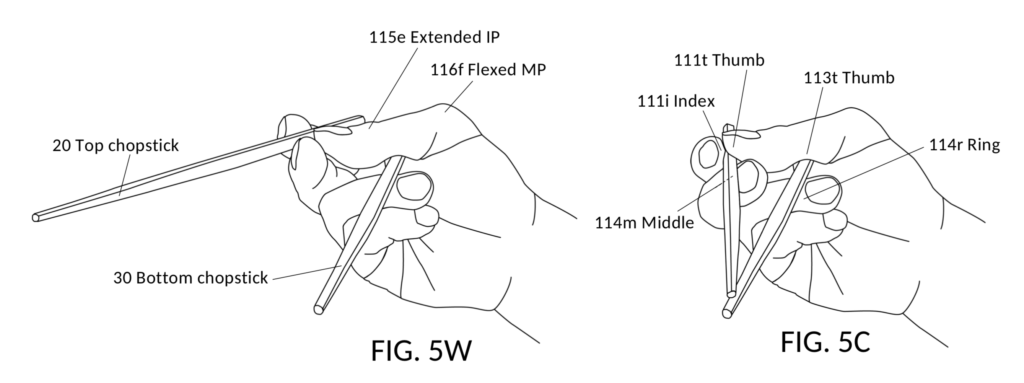
At the same time, the base of the thumb (the second segment) is instrumental in holding the bottom stick immobile. The thumb base pins the bottom stick against the knuckle of the ring finger, as well as the purlicue (not visible in FIG. 5W and 5C). This is why the MP joint needs to be flexed. An extended MP joint would not be able to pin the bottom stick in place, but instead would present a slanted skin surface that pushes the bottom stick closer toward the top stick.
Now we know what the Caswellian thumb is. We also know why it is needed for the Standard Grip.
Why Caswellian thumb is hard
We suspect that some people have hereditary conditions preventing them from adopting the Caswellian thumb pose.
The human hand is not all built the same way. There is a substantial variation in how muscles, joints and nerves are built and connected. Dozens of muscles coordinate, to move fingers. In some people, these muscles originate from different parts of bones. In others, these muscles and their tendons are inserted into different finger bones. Innervation can be very different in different individuals. Lastly, some of these muscles are missing altogether, in large percentage of people.
Here is a research finding representing just one of the plethora of research work that shed light on the variety of hand builds. This particular paper highlights the variations in just one aspect of one muscle, the flexor pollicis brevis. As we will see later, this muscle is part of the thenar eminence. Muscles in the thenar eminence are responsible for flexing the thumb MP joint. Therefore, a properly wired thenar eminence is crucial to the Caswellian thumb.
Based on our observations, we believe that a sizable human population exists, where a person can comfortably perform the thumbs-up gesture and the closed-fist gesture, but cannot sustain the Caswellian thumb.
In medical French, this implies that they have functional extensor pollicis longus, extensor pollicis brevis, and flexor pollicis longus. But something in the thenar eminence group is unable to flex the thumb MP joint with enough force, to counteract unintentional extension forces on the same joint by other functional muscles attempting to extend the thumb IP joint.
The thenar eminence comprise three muscles: abductor pollicis brevis, flexor pollicis brevis, and opponens pollicis. Biomechanically, any movement is a combination of muscles, joints, and nerves that control the muscles. So there are many factors that may affect a hand’s ability to hold the Caswellian thumb.
It is not clear why Caswellian thumb is not a universal human trait. It seems like such trait should have long spread through the human gene pool. After all, tasks such as grasping a thin slice of a leaf required it, when we evolved among the great apes. Even today, great apes fish for termites using tree branches, where they almost appear to wield the Caswellian thumb pose. Holding a thin branch seems like a precursor to holding pens and chopsticks, to us.
On the other hand, Caswellian thumb is but one of dozens of opposition grips that humans wield today. Perhaps in the grand scheme of things, it is not as important as the rest of grips and pinches. The truth is, actual survey of chopstick users by us, and actual pencil grip studies such as Selin 2003, turn out large number of grips where the thumb tip is naturally bent. It appears that a bent thumb is more comfortable for humans, than a Caswellian thumb. We’ll pick up this theme again in a later section on modern pen grips.
Why the name Caswellian?
We didn’t want to invent new medical terms, if we didn’t have to. But despite extensive search, we found no established literature that described this chopstick thumb pose. So we took inspiration from an earlier article of ours: Hold Chopsticks like a Pen.
In that article, we found that the modern world have moved on, from old-style pen grips, to modern grips. We didn’t have a clue why, at the time. But we now have an inkling of the reason behind such change.
Following illustrates two variants of an old-style pen grip. They are essentially the same, except that the wrist is rotated more in one, and less in the other. This is from a 1923 book by Guy Rich Caswell.
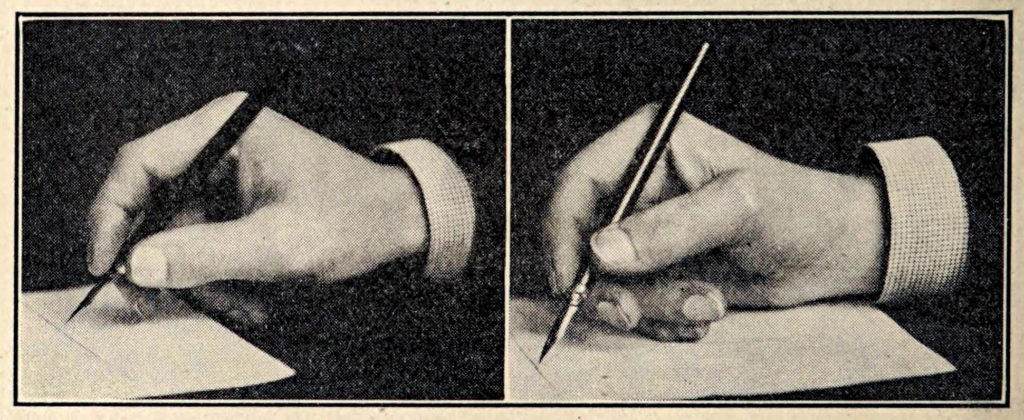
Now compare the old-style pen grip, to the Standard Grip. One can objectively confirm the tripod hold in this pen grip. It’s the same as found in Standard Grip, comprising the same flattened thumb, and two curved fingers: index and middle. Thus, we name this thumb pose the Caswellian thumb.
Following is an re-enactment of this old-style pen grip. Believe it or not, some of us still use this Caswellian grip in our daily lives. The Caswellian thumb is highlighted on the left.
Here is another comparison of the pen grip to Standard Grip. This time the chopstick grip is shown from a different angle.
Modern pen grips
It was mentioned earlier, that the world appears to have moved onto modern pen grips. We went into more depth in Hold Chopsticks like a Pen. Here are some samples of modern grips.
These modern grips are all different from each other. Some are closer-looking to the old-style grip, such as the rightmost one shown above. Some are very different, such as the dynamic tripod on the left, and the lateral tripod in the middle.
Following are five types of modern grips observed and documented in Selin 2003. The first two are dynamic tripod and lateral tripod. These basic types constitute one dimension in Dr. Selin’s classification of 504 observed grips.
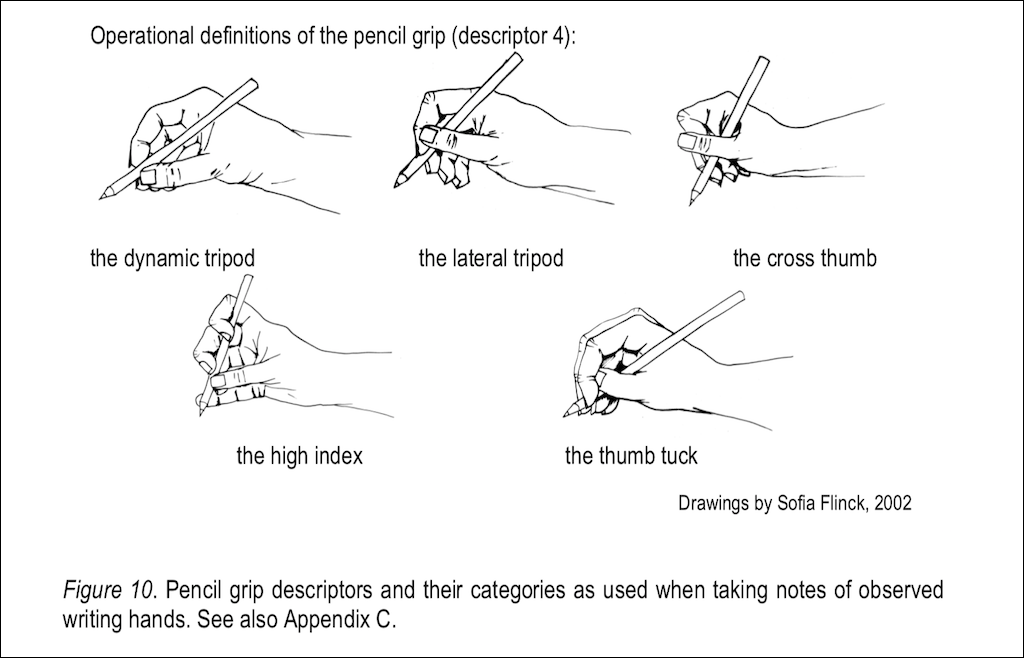
In addition to the “type” classification, every grip is also evaluated based on 3 more descriptors: the angle of the wrist, the DIP joint of the index finger, and of special interest to us, the IP joint of the thumb.
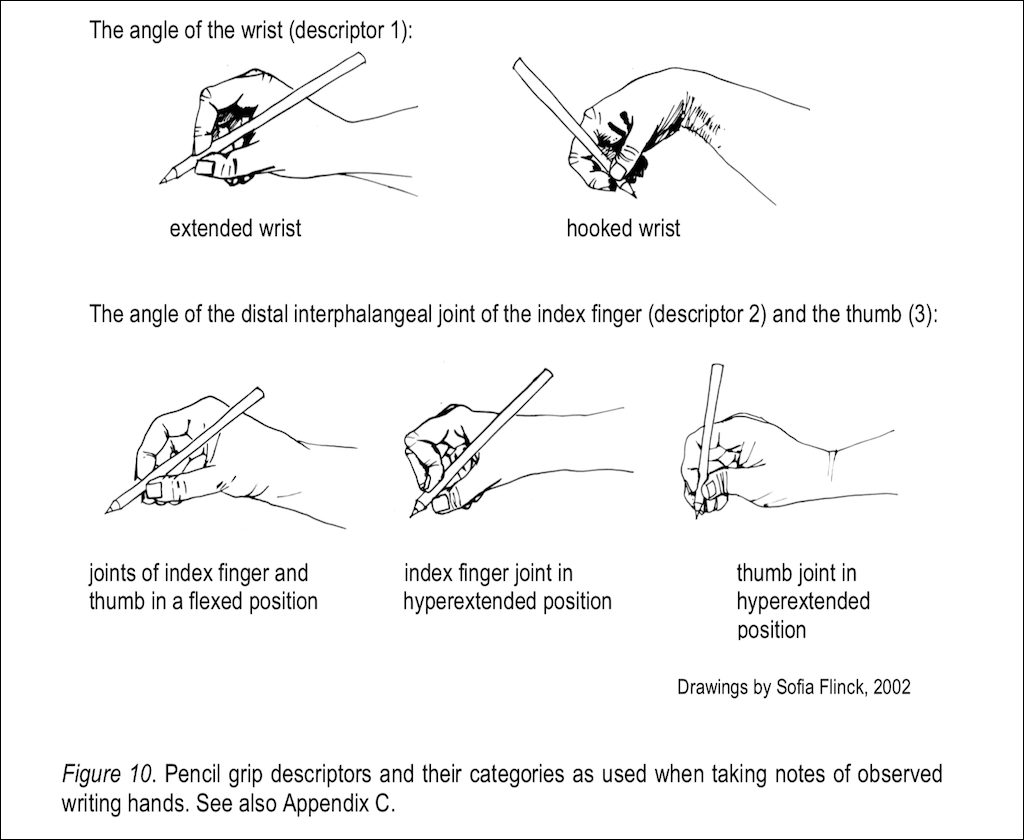
Descriptor 3 evaluates the thumb IP joint in terms of flexed vs hyperextended. Out of 504 recorded grips, 499 used flexed IP joint, while 5 used hyperextended. The hyperextended thumb observed in 1% of participants in this study is the Caswellian thumb pose.
Thus, all modern grips have one thing in common. They do not call for the IP joint of the thumb to be flattened. That is, they do not employ the Caswellian thumb.
Perhaps the Caswellian thumb is, as we suspect, not universally comfortable. The world simply moved on from it spontaneously.
Another finding from this research shows that about 64% of participants showed hyperextended index finger DIP joint. This probably have something to do with our corroborating observation in chopstick grips. More and more users are hyperextending their index DIP joint, especially with alternative grips where the thumb tip remains unused. These can be observed in Idling Thumb, Chicken Claws, and Scissorhand. See the article: Using vs not using the Thumb.
In our how-to-use-chopsticks instruction cartoon, we advise that learners “secure the top stick as if holding a pen”. This is printed on millions of chopstick wrapper sleeves as well, as we mentioned in many articles, such as this one.
This was a sound advice, in the past, when more people used the Caswellian pen grip. In today’s world, however, this may no longer be the right advice. If a learner holds the top stick using their own modern pen grip, then they would end up wielding the Standard Grip.
If you want to go down the pencil grip rabbit hole, we recommend Pencil grip. A descriptive model and four empirical studies, by Dr. Ann-Sofie Selin, 2003. This book is 127 pages long. It includes large number of nice illustrations of pencil grips. It references a wealth of prior research. We use it as both first-hand research information, as well as a map to related research.
How to confirm anatomical constraints
You may suspect that you have issues holding the Caswellian thumb pose. But don’t panic. Perhaps you are a first-time learner, and your muscles simply haven’t be tasked to do this unnatural pose before. By following the instructions in Learn to Use Chopsticks, in time you will be able to build up enough muscle strength.
After repeated attempts, you still can’t get that Caswellian thumb pose. We have some leads for you to follow. But first, you should confirm that you can do the thumbs-up gesture and the closed-fist gesture. If you can’t do either of them, then you have other issues we don’t cover in this article.
Perhaps you have recently sustained a hand injury. Perhaps you fall somewhere in the spectrum between people who can super-flex their thumbs, and those who are missing some key muscles. Then, you can use the following video to do a rudimentary check. There are two tests shown in this video. The first test is the one to pay attention to. It tests whether you have enough flexing strength at the MP joint. If you don’t, Caswellian thumb will be hard for you to sustain.
Next, jump to time 2:43 of a second video. And follow tests shown, after the brief introduction. These examine the opposition of the thumb, but do not specifically test for straight or flexed thumb IP joint.
In addition to following the video, also find out whether you can maintain a flat Caswellian thumb, while attempting to touch the tip of the index finger, the tip of the pinky, and the base of the pinky. It should be increasingly harder to do, as you go down those three targets.

If you cannot keep a flat Caswellian thumb at all, when touching the tip of the index finger, then the Standard Grip will be difficult for you to wield.

In some cases, a user can make a strenuous effort to flatten the thumb IP joint during these tests. But the pose cannot be sustained for long.
At the end of the day, if holding chopsticks using Standard Grip taxes your hand and fingers, then perhaps you do suffer from this constraint. If you get chopstick cramp often, you probably have this condition.
Coping with anatomical constraints
Some people find it difficult to make the Caswellian thumb pose. Some are able to force the thumb into this pose temporarily, but cannot hold this pose for long.
Yet others find creative ways to cope with their anatomical constraints, such as adapting the Count-to-4 grip.

Following is a video illustrating the Count-to-4 grip from various angles. Note the bent thumb, and the unusual, idling index finger draped over the top stick.
Despite these differences from Standard Grip, Count-to-4 as an alternative grip actually uses the same planetary gear principle to twirl the top stick. Instead of a tripod hold, it deploys a bipod hold, comprising the thumb and the middle finger.
With Count-to-4, the thumb pushes the top chopstick outward, in order to extend tips of both sticks apart. This small sideway push by the thumb is amplified by leverage, thus extending tips wider than achievable via only twirling. This is an example of what we call sideway swing.
Not surprisingly, the same person wields a pen (left) using exactly the same finger posture and dynamics as they wield chopsticks (center and right).

Given what we now understand, we no longer believe that blindly prodding all children and adult learners to use Standard Grip is right. The Standard Grip is objectively the most powerful and the most efficient grip. But some simply cannot wield it, no matter how hard they try.
We can direct those burdened with this anatomical issue to adopt an alternative grip such as Count-to-4. In addition, there is yet one more way to cope with this issue. Folks can print out a pair of training marcosticks, as we will presently discuss.
Finger helper marcosticks
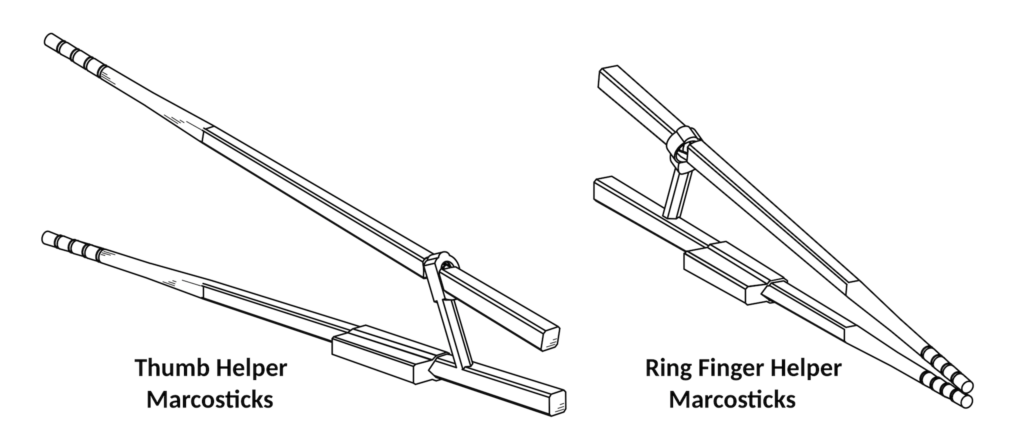
Finger helper bars are designed specifically for those who can’t make the Caswellian thumb pose. These helper bars, when mounted on model T training marcosticks, allow these users to wield the Standard Grip, despite a bent thumb pose.
Following clip features a user who were never able to wield the Standard Grip all his life, until he tried the ring finger helper. Note how his thumb MP joint remained flexed (bent) throughout the exercise.
This user could not hold the bottom chopstick using the 1-on-2-support thumb pose, in the past, because of personal anatomical limitations in his finger muscles. With the ring finger helper, he can now secure the bottom chopstick.
Many life-long chopsticks users went to their graves still puzzled over why they could never master the Standard Grip. For some of them, this undiagnosed Caswellian thumb condition might have been the reason. And finger helper bars could have been the answer.

Pictures above illustrate how a helper bar creates distance between the thumb and the ring finger. It allows the thumb to remain in the “closed-fist” pose which most people can manage. With the helper bar, the bent thumb is now able to secure the bottom chopstick using the 1-on-2-support mechanism.
In short, the helper bar allows a learner to stop worrying about securing the bottom chopstick. Thus, the bar is also a useful aid for learners who don’t actually have anatomical limitations. A learner initially leans on the bar as a crutch, to secure the bottom chopstick. The learner can then focus instead, on twirling the top chopstick with the tripod hold.

You can print your own helper bars on your 3D printer. Head to the 3D printing section of the finger helper article, for 3D models and instructions. For other learner and training tools, consult the catalog at the 3D-printing page. If you don’t have a printer, you can get one from our partners.
Chopstick Buddies
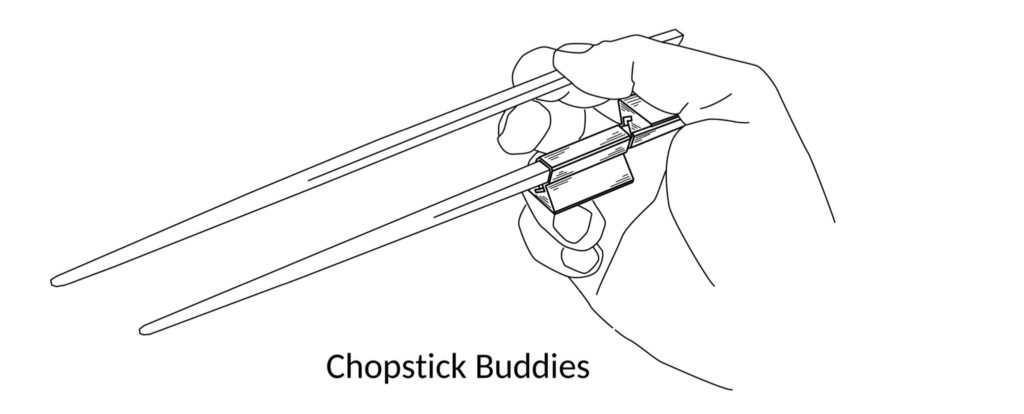
Chopstick Buddies are attachments to a plain chopstick. They are designed for beginners, and for a sizable population who cannot hold unaided the Caswellian thumb pose required by the Standard Grip.
While looking simple, Chopstick Buddies are a culmination of years of research on chopsticks that resulted first in Ergonomic Marcosticks, then Training Marcosticks and Finger Helpers. Finger Helpers, in particular, directly led to Chopstick Buddies.
Chopstick Buddies fixes Standard Grip in the same way Finger Helpers do, with one difference. Chopstick Buddies do not require model T training marcosticks. They can be used with any plain chopsticks you fancy.
The following video shows how to attach two chopstick buddies to a chopstick. The buddie with a wider support surface props up the base of the thumb. The buddie with a narrower support surface abuts the knuckle of the ring finger.
The next video shows how these two chopstick buddies help a learner avoid the unnatural thumb pose that Standard Grip otherwise requires. The split screen at the top shows the unnatural thumb pose required by Standard Grip. Notice how close the base of the thumb is to the ring finger, vertically speaking. Observe how the thumb needs to be flattened, while the thumb base is forced very closed to the ring finger.
The split screen on the bottom show the same hand wielding Standard Grip, this time without needing to hold this unnatural thumb pose. This is made possible, because the two buddies allow the thumb base to be far separated from the ring finger. It allows the user to bend the tip segment of the thumb – a much more comfortable pose.
Chopstick Buddies share many similarities with Finger Helpers. They take different approaches to solve the same underlying issue: the Caswellian thumb problem.
Hyper-Caswellian thumb
A sizable percentage of the population can hyperextend their thumb IP joint. The colloquial name for this is hitchhiker’s thumb. Another common name for this is double-jointed. These gifted folks can use the Standard Grip with ease. Not only can they sustain the Caswellian thumb, they can also accentuate one of its key roles: keeping the two sticks separate.
The hyperextended thumb forms a deep V shape. The slope of the base of the thumb is such that is tightly cages the bottom stick immobile. This V shape keeps the top stick well separated from the bottom stick, which is essential to the Standard Grip.
In addition, the the hyperextended thumb makes the tripod hold more dexterous, enhancing its rolling of the top stick.
2021-05 updates: Lateral chopstick grips
It took us two years of data collection, before we discovered the largest chopstick grip family. In the first two years, we filed away videos we took of odd grips that we could not yet explain. It wasn’t until we amassed enough of these that we finally found common patterns in them. It wasn’t until we gained enough insights about other grips, than we were then able to look at these seemingly one-off grips, and started to articulate how wildly-different variants were actually predicated by our theories such as the three types of chopstick swings.
We are excited to present to you, the large family of Lateral grips. This family include such colorful members as Lateral Chick, Lateral Squid, and Lateral Gangnam Style, based on the the form taken by the hand, as it pries open chopsticks to extend tips apart, shown below.
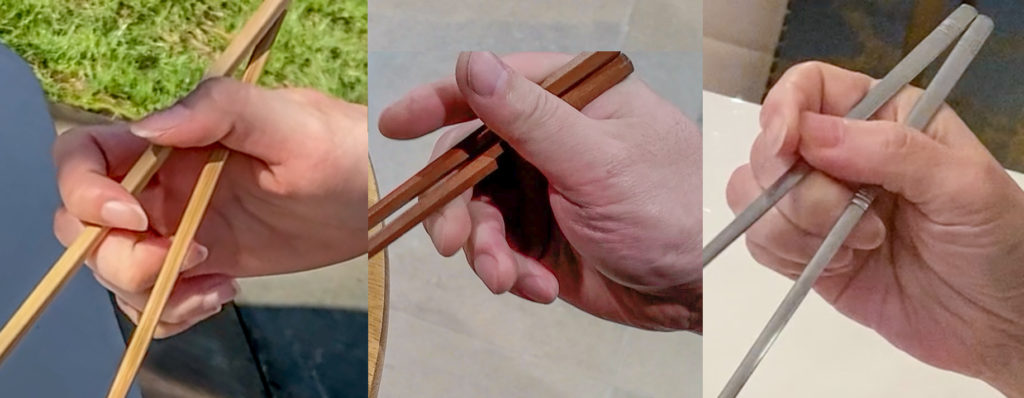
Despite their varied look at the Open posture, all of these Lateral grips look like the picture shown below, when their practitioners clutch the two chopsticks closed, in the Compression posture.
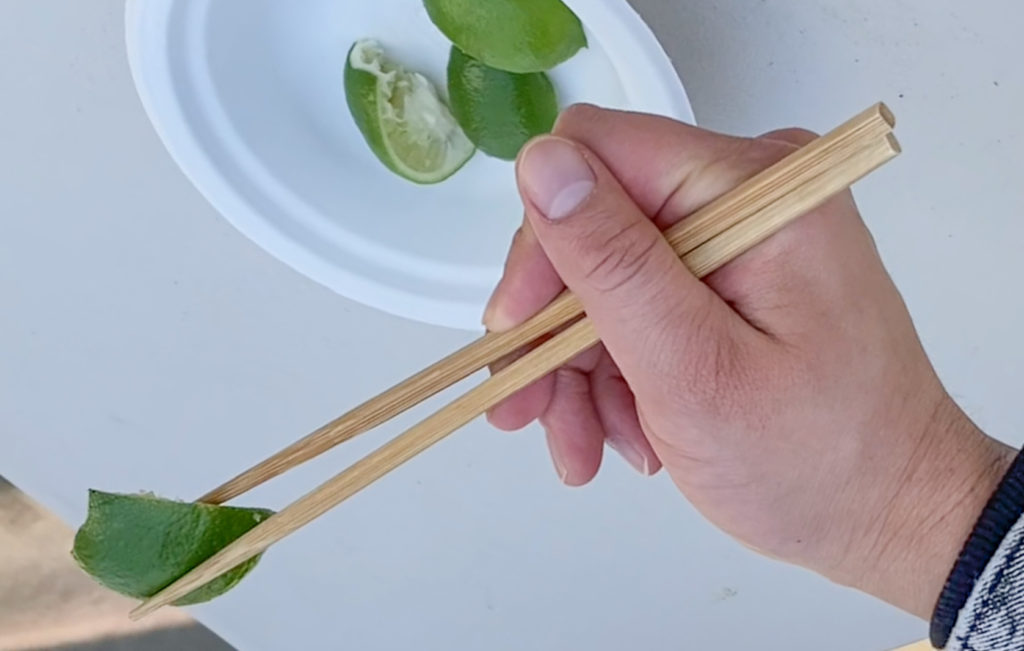
Readers of this article can immediately spot the key salient point of this Compression posture. These Lateral grips do not require the Caswellian thumb pose, mostly because the tip segment of the thumb is not used. This fact is even easier to appreciate when the posture is shown from different point of views, as we will shortly show.
We hypothesize that Lateral grips are popular, partly due to them eschewing the unnatural Caswellian thumb pose. This is a consequence of the disuse of the tip of the thumb. Note how the Lateral grip shown below left uses a comfortable thumb pose similar to the thumbs-up gesture shown in FIG. 4A. That is, both MP joint and IP joint of the thumb are flattened at 180°.
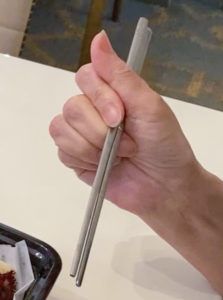
Not all Lateral grips adopt the thumbs-up gesture. Many make use of the closed-fist thumb pose. Another Lateral grip is shown below left. This one employs a comfortable thumb pose where both MP joint and IP joint of the thumb are bent.
A variation of the closed-fist gesture is where neither MP joint nor IP joint are bent at 90°. Some Lateral grips adopt this thumb pose half-way between closed-fist and thumbs-up. One such Lateral grip is shown below left.
Update 2021-05: in popular culture
In May 2021 we analyzed an excellent episode on chopsticks and chopsticking by World Friends YouTube channel. We published a writeup of this review in YouTube episode on chopsticking from WorldFriends.
All three hostesses wield more than one chopstick grips. Two of three hostesses naturally use Lateral compression which do not require the Caswellian thumb pose.
The hostess Hyejin believes that she primarily uses Scissorhand. But actual observations show that she switches to Lateral Thumb Wrestler as often as she uses Scissorhand. These two grips differ only in how they extend chopsticks apart. Both grips clutch chopsticks closed with the same Compression posture. None of grips she uses require the Caswellian thumb pose.
As Hyejin verbalized and demonstrated, she too is able to wield Standard Grip. This is illustrated below.
We find similar stories from practitioners we survey. Many practitioners of alternative grips know and can demonstrate finger movements from Standard Grip. But most find it unnatural to use in real life, or simply find the grip they grew up with more comforting. Some of these anatomical issues are documented in this article.
It is time we embrace alternative grips. We can and should celebrate practitioners who master more than one grip. As mentioned, all three hostesses in this episode wield more than one grip type.
Instagram pictures
#ChopstickCramp
—-
- Yeah. We know some frogs, koalas, pandas, possums and opossums also have opposable digit of some sort. Point taken. Thanks.
* pictures courtesy of u/lesserweevils and u/sudakifiss.

